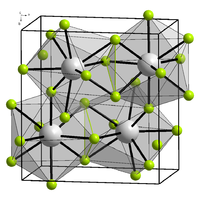Yttrium(III) fluoride
 |
|
| Names | |
|---|---|
| Other names
yttrium trifluoride
|
|
| Identifiers | |
|
3D model (JSmol)
|
|
| ChemSpider | |
| ECHA InfoCard | 100.033.855 |
|
PubChem CID
|
|
|
|
|
|
| Properties | |
| YF3 | |
| Molar mass | 145.90 g mol−1 |
| Appearance | white powder |
| Density | 4.01 g cm−3 |
| Melting point | 1,387 °C (2,529 °F; 1,660 K) |
| Boiling point | 2,230 °C (4,050 °F; 2,500 K) |
| insoluble | |
| Solubility in acid | soluble |
|
Refractive index (nD)
|
1.51 (500 nm) |
| Structure | |
| Orthorhombic, oP16, SpaceGroup = Pnma, No. 62 | |
| Hazards | |
| Flash point | Non-flammable |
| Related compounds | |
|
Other anions
|
Yttrium(III) chloride Yttrium(III) bromide Yttrium(III) iodide |
|
Other cations
|
Scandium(III) fluoride Lanthanum(III) fluoride |
|
Except where otherwise noted, data are given for materials in their standard state (at 25 °C [77 °F], 100 kPa).
|
|
|
|
|
| Infobox references | |
Yttrium(III) fluoride is an inorganic chemical compound with the chemical formula YF3. It is not known naturally in 'pure' form. The fluoride minerals containing essential yttrium include tveitite-(Y) (Y,Na)6Ca6Ca6F42 and gagarinite-(Y) NaCaY(F,Cl)6. Sometimes mineral fluorite contains admixtures of yttrium.
YF3 can be produced by reacting fluorine with yttria or yttrium hydroxide with hydrofluoric acid.
It occurs as the mineral waimirite-(Y).
Yttrium(III) fluoride can be used for the production of metallic yttrium, thin films, glasses and ceramics.
Conditions/substances to avoid are: acids, active metals and moisture.
...
Wikipedia
